When you think about time, what are you doing in your mind?
April 2023
A few months ago, I came across a series of TikTok videos in which people explained how they think about time. (I hope I haven’t lost you already at the mention of TikTok - please stick around!). Some described picturing a static calendar, much like the digital one we have on our phones. Others simply pictured a line, which ‘zooms in’ from years to months to days. However, a number of people had far more elaborate constructs of time in their mind, such as time forming a ring around them in space (an example of time-space synaesthesia: experiencing time as a spatial construct).
I became fascinated by the range of ways in which people constructed time in their minds, and my favourite question became ‘When you think about time, what are you doing in your mind?’. This question evoked a vast range of answers, from complete confusion, to detailed explanations much like those in the videos I had watched. In most cases, I would have to explain my mental depiction of time in order to convey what the question meant. However, for most, this led to even more puzzlement. (Apologies to everyone who was subjected to this more times than they wished!)
I quickly came to realise that the way I think about time is quite different, and potentially more complex, than many. I felt that my verbal explanations, although at times aided by props such as menus and my phone, were not doing a sufficient job at conveying how I view time. So, I am writing it up for those that are interested! In an ideal world I’d create a VR experience of this for you. However, for now at least, I’ll just use words and images.
How I think about time.
Here goes: my mental depiction of time.
I’ll start with a summary, and then build up the picture step-by-step. Examples and diagrams will be my friends. If the summary doesn’t make any sense to begin with, feel free to refer back to it as you read; hopefully it will make complete sense by the end!
I view time spatially, as 2D planes in 3D space. Each plane represents a different unit of time (hour, day, month etc.). These planes are dynamically oriented relative to the point in time I am thinking from, and depending on the point in time I am thinking about. Furthermore, I affix ‘events’ (absolutely anything that has a time or date associated with it) to these 2D planes as blocks, to create a ‘mental calendar’. I permanently travel around these planes: at any point in time, I am somewhere on each of these planes. When picturing time, I am traversing these planes as if I am on them.
I picture:
- Hours as a circle, like an analogue watch face.
- Days as a circle, like an analogue watch face. (Since there are 12 hours, this ‘loops’ over itself, but it’s still possible to see both 1am and 1pm in the same image.)
- Days of the week as list of 7 rectangular blocks.
- Months as rectangles, made up of the ‘week’ blocks.
- Years as squares, made up of the 'month' blocks.
The following diagrams aim to depict this. (Ignore the red head and shoulders for now.)


As a slight twist, months of the year are not laid out as a standard calendar, as you may expect. January, February, March and April assume the top line, and May, June, July the second. August is sort of on a third line on its own, and the rest of the months are all on the same line as each other, slightly indented because of August. The diagram below attempts to convey this. However, the months don't actually look like this in my mind, because whenever I view the year I am never looking at every month concurrently. Instead, it appears far more like there are three rows, and with no gaps in between each month.
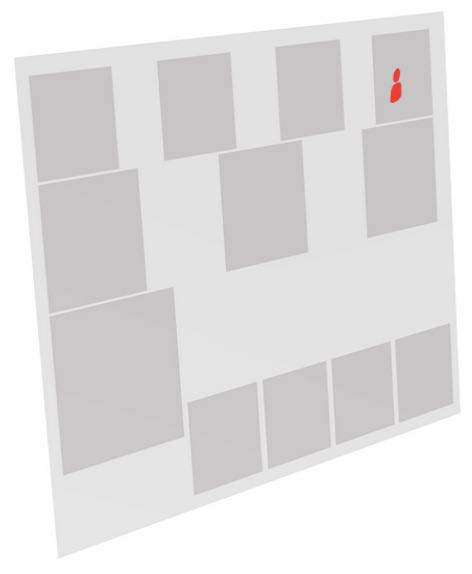
Furthermore, the following diagram depicts how I think about years and centuries. The number of years I see depends on how zoomed-in I am, or what scale I’m thinking about. There is a big black divide at the year 2000. The long, thin planes are actually a series of squares (one for each year) which get merged together the further zoomed-out I get.
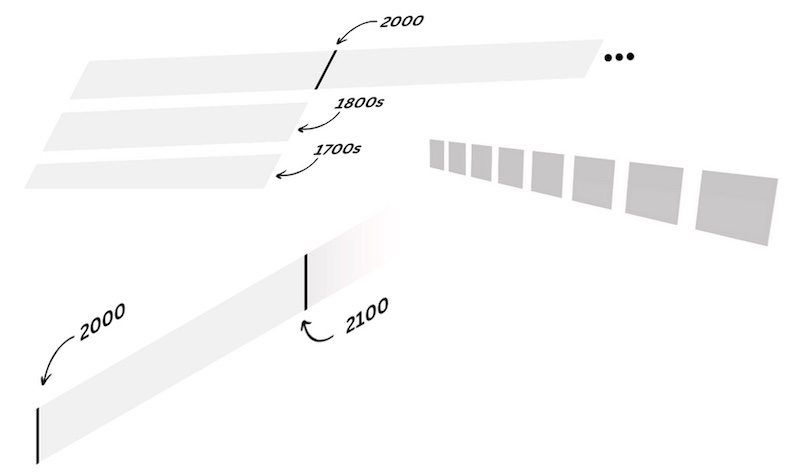
The orientation of the diagrams above is incredibly deliberate; it attempts to mimic how I see the planes in 3D space. Though, the angles aren’t perfect, and do change depending on my perspective.
Another (somewhat confusing) thing to note is that, although I have presented you with separate diagrams for each unit of time, larger units are in fact constructed of smaller units, in such a way that they blend in and seamlessly transition between each other. That is, each representation exists simultaneously. For example, when thinking about a day of the week, the rectangle representing the day of the week on the week plane is equally the layered circles at the same position on the week plane as that rectangle; the layered circles are ‘within’ the week plane. (I have omitted a diagram trying to depict this as I fear a visual depiction of these overlapping representations of time units would provoke more confusion than simply providing this written explanation alone!)
So far, quite simple. What we’re seeing is that I pretty much picture time like analogue clocks and digital calendars. And the pictures of these things are straightforward! But now it gets more complicated.
How I view a certain unit of time (hour, day, week etc.) changes according to what I am thinking of relative to it. It’s like I’m positioned at the point in time I am thinking from, and the perspective of the point in time I am thinking about depends on this.
Let’s say that it’s a Friday afternoon at 2:30pm on the 7th of April, since that’s what time it is now. What this looks like, from the perspective of being at this time, varies depending on what I’m thinking relative to:
- Relative to the hour, which I picture as a circle oriented upright straight ahead, I am at the bottom. When I think about 15 minutes’ time, that’s up and to the left. If I think about 15 minutes ago, that’s up and to the right. Seems pretty standard to me, I think: it’s just like an analogue clock, where I am positioned at the current time.
- Relative to the whole day, I’m where 2:30pm would be on an analogue clock.
- Relative to the week, I’m just past the centre of the 5th block.
- Relative to the month, I’m most of the way down the first block.
- Relative to the year, I’m towards the end of the first row.
Diagrams portray this more clearly than words: in the images above, I have represented myself by the red head and shoulders. When I say ‘I am there' on the plane, what I mean is that it feels as if that is the position I am occupying on the plane.
So far, I’ve only explained how I think about the specific time that I am presently at. Now, let’s consider thinking about times in the past or future. If I’m thinking about a time that I’m not currently at, it’s always from the perspective of some other time.
A point to note before reading on: my diagrams depict the ‘whole picture’ of each plane. In actual fact, I am viewing these planes from the perspective of being on them (I am ‘at’ the red dots). As my vision only stretches so far as my peripheral vision, parts of these planes are behind me. I wasn’t entirely sure how to portray this clearly through diagrams, so I’ve gone with the ‘whole picture’ style.
For example, let’s consider times later this evening. The following images depict how my perspective changes depending on the time I’m thinking about and where I currently am (in time).

Now, let’s consider the morning on Sunday 9th April. Given that it’s presently Friday afternoon, the week is aligned at the angle shown on the left in the diagram below. Pretend instead that it is Friday morning, then the angle would completely change, as shown in the right-hand image. To improve visability, the right-hand image is not tilted away at as-steep an angle as it is in my mind; otherwise, you would only see the underside of the plane.

If I think about Monday 10th April, then again the angle changes. Similarly, it changes when I think about last weekend instead.
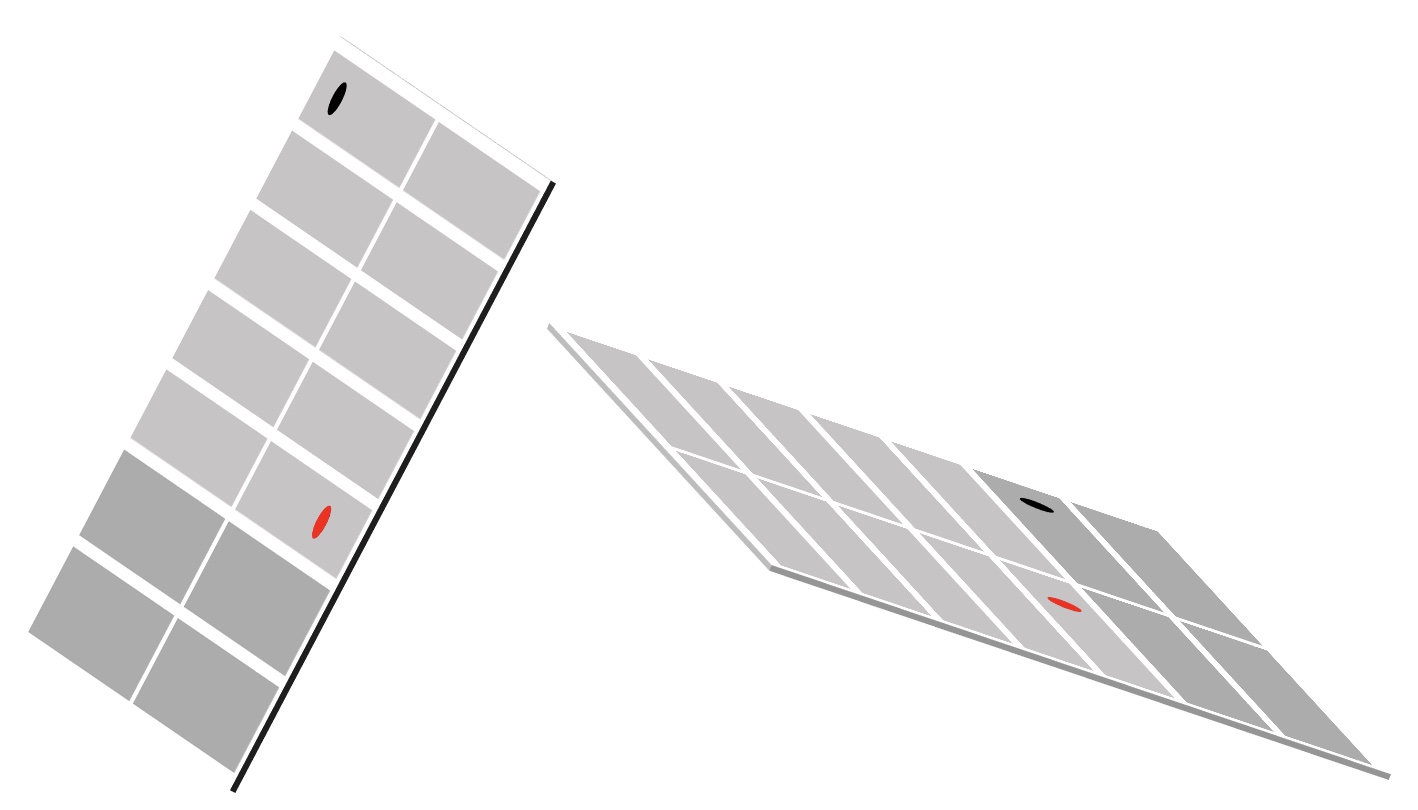
If I was to think about February just gone, or May coming up, this is what I’d see.

For months last year or next year, a second 'year square' comes into focus.
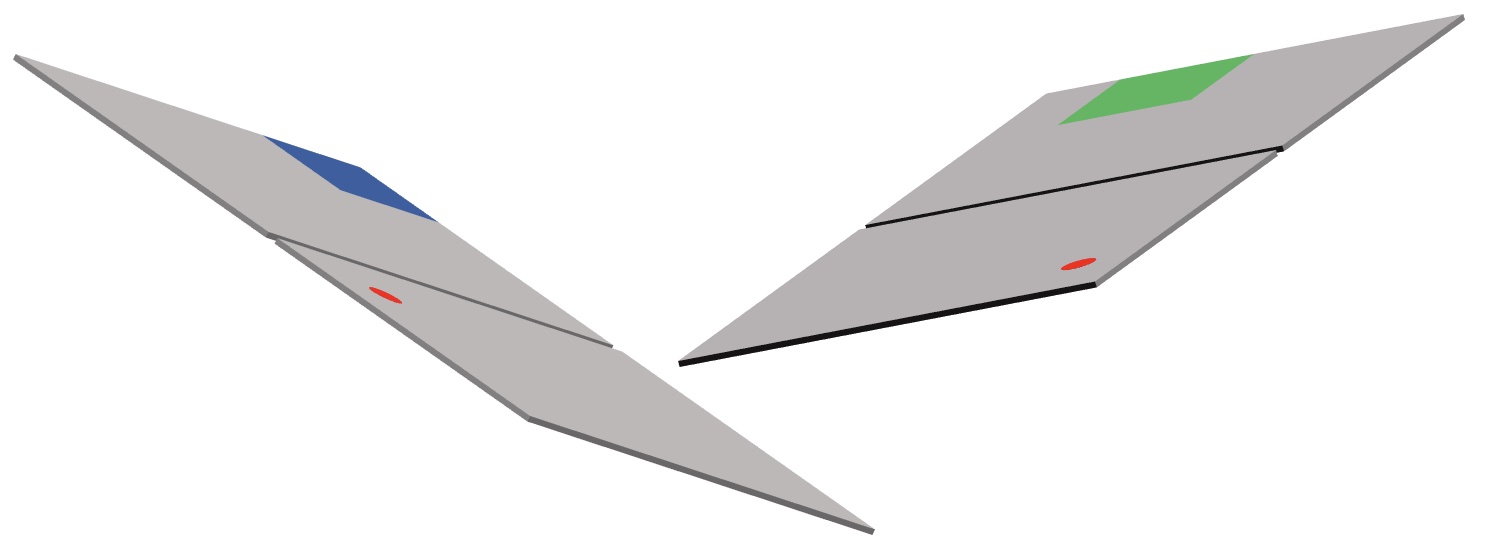
(And yes, months do have colours.)
Thinking about years further away orients the year planes, too.

Hopefully the ‘orientation’ part of my summary explanation is clear now. Basically, these planes representing the different units of time orient themselves based on the perspective of where I am viewing that time from.
Now for the final detail.
In my mind, certain parts of the blocks are shaded. (I think they’re coloured in my mind, rather than greyscale as I’ve depicted most of them, but not clearly enough for me to be able to tell you the colours.) The shaded areas correspond to ‘events’. That is, something on at that time. For example, this evening I’m watching a movie, so this is blocked out. On Sunday, I have a roast with my friend for the most part of the day, so there is a block on top of Sunday. Moreover, on Monday, my landlord has invited me to a dinner party, so this is another block.
For each event, I plonk it onto my mental depiction of time. This is mainly for specific days, from either a day, week or month perspective. On that day, I will view the block from the perspective of the current time of day.
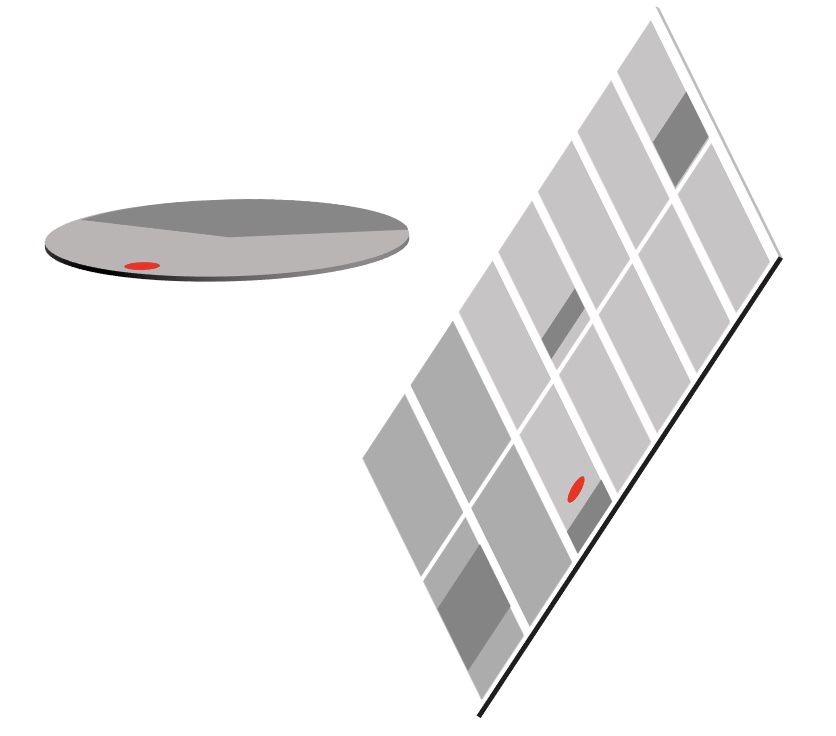
These ‘blocks’ act as a mental calendar; I don’t need to rely on a physical one. It always puzzled me as to why people relied so heavily on their planners at school, or why their phone calendar records literally everything they do. Now, I realise it’s because they don’t have a mental calendar in the same way that I do. Maybe having my mental calendar is advantageous, but it could also be a complete waste of mental energy!
I can’t think about time without creating these mental constructs that I’ve just described. For every thought which involves time in some form, from a specific time to an event that has or is going to occur for me or someone else, the pictures that I’ve just explained to you consume my mind. This applies to both internal (my own mentions of time or events in my thoughts) to external (other people talking about times/events). I therefore spend a considerable proportion of my day travelling my inner world of time (probably not the best use of my time!).
Conclusion.
I hope you enjoyed reading my explanation of how I think about time. For those of you who had to put up with my verbal explanations, I hope it’s now clearer. If you've got any questions, or anything isn't comprehensible, please reach out. And if this post has got you thinking, let me know! If you liked this post, be sure to check out my related ones on thinking about arithmetic, thinking about maths, and designing our thinking.
I'll conclude this post with some exciting questions to ponder:
- Why is it that so many of us have such different ways of thinking about time?
- How much of the way we think about time is how we are first taught what time is? For example, I know that the reason I think of weeks in a line is because a kitchen cupboard when I was younger had an A4 piece of paper with the days of the week listed in a line. Furthermore, the reason I think of a day in a circle is because I was taught time on an analogue clock. (I can’t begin to imagine how different my mental time construct would be had I based times of day on a digital clock!)
- Is there an advantage to thinking about time spatially? For example, is my method of ‘plonking’ blocks representing events onto my mental calendar a more efficient time-management technique than using a physical calendar?
-
If there are advantages to certain ways of thinking about time, can these be taught?
(It would be great to read research on this - let me know if you know of any!) Could
this research lead to teaching of ‘optimal’ ways* to think about time?
*Plural, because ‘optimal’ would be very different for different thinking extremes like aphantasia, for example. - Could we make personalised calendars that reflect how an individual thinks about time? Would this be more useful, rather than constraining everyone to constantly translate between their mental depiction of time to a standard calendar?
- How much time do you spend in your mental depiction of time?
- Do you conjure up your mental depiction of time at every mention (internal and external) of time and events, or is it context-dependent?